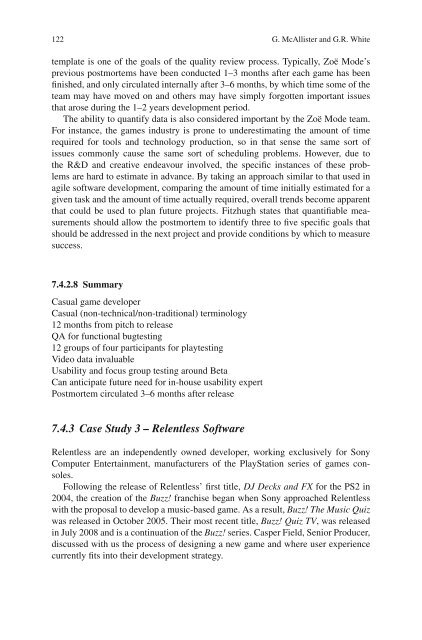Evaluating User Experience in Games: Concepts and Methods - Lirmm
Evaluating User Experience in Games: Concepts and Methods - Lirmm
Evaluating User Experience in Games: Concepts and Methods - Lirmm
You also want an ePaper? Increase the reach of your titles
YUMPU automatically turns print PDFs into web optimized ePapers that Google loves.
122 G. McAllister <strong>and</strong> G.R. White<br />
template is one of the goals of the quality review process. Typically, Zoë Mode’s<br />
previous postmortems have been conducted 1–3 months after each game has been<br />
f<strong>in</strong>ished, <strong>and</strong> only circulated <strong>in</strong>ternally after 3–6 months, by which time some of the<br />
team may have moved on <strong>and</strong> others may have simply forgotten important issues<br />
that arose dur<strong>in</strong>g the 1–2 years development period.<br />
The ability to quantify data is also considered important by the Zoë Mode team.<br />
For <strong>in</strong>stance, the games <strong>in</strong>dustry is prone to underestimat<strong>in</strong>g the amount of time<br />
required for tools <strong>and</strong> technology production, so <strong>in</strong> that sense the same sort of<br />
issues commonly cause the same sort of schedul<strong>in</strong>g problems. However, due to<br />
the R&D <strong>and</strong> creative endeavour <strong>in</strong>volved, the specific <strong>in</strong>stances of these problems<br />
are hard to estimate <strong>in</strong> advance. By tak<strong>in</strong>g an approach similar to that used <strong>in</strong><br />
agile software development, compar<strong>in</strong>g the amount of time <strong>in</strong>itially estimated for a<br />
given task <strong>and</strong> the amount of time actually required, overall trends become apparent<br />
that could be used to plan future projects. Fitzhugh states that quantifiable measurements<br />
should allow the postmortem to identify three to five specific goals that<br />
should be addressed <strong>in</strong> the next project <strong>and</strong> provide conditions by which to measure<br />
success.<br />
7.4.2.8 Summary<br />
Casual game developer<br />
Casual (non-technical/non-traditional) term<strong>in</strong>ology<br />
12 months from pitch to release<br />
QA for functional bugtest<strong>in</strong>g<br />
12 groups of four participants for playtest<strong>in</strong>g<br />
Video data <strong>in</strong>valuable<br />
Usability <strong>and</strong> focus group test<strong>in</strong>g around Beta<br />
Can anticipate future need for <strong>in</strong>-house usability expert<br />
Postmortem circulated 3–6 months after release<br />
7.4.3 Case Study 3 – Relentless Software<br />
Relentless are an <strong>in</strong>dependently owned developer, work<strong>in</strong>g exclusively for Sony<br />
Computer Enterta<strong>in</strong>ment, manufacturers of the PlayStation series of games consoles.<br />
Follow<strong>in</strong>g the release of Relentless’ first title, DJ Decks <strong>and</strong> FX for the PS2 <strong>in</strong><br />
2004, the creation of the Buzz! franchise began when Sony approached Relentless<br />
with the proposal to develop a music-based game. As a result, Buzz! The Music Quiz<br />
was released <strong>in</strong> October 2005. Their most recent title, Buzz! Quiz TV, was released<br />
<strong>in</strong> July 2008 <strong>and</strong> is a cont<strong>in</strong>uation of the Buzz! series. Casper Field, Senior Producer,<br />
discussed with us the process of design<strong>in</strong>g a new game <strong>and</strong> where user experience<br />
currently fits <strong>in</strong>to their development strategy.

















